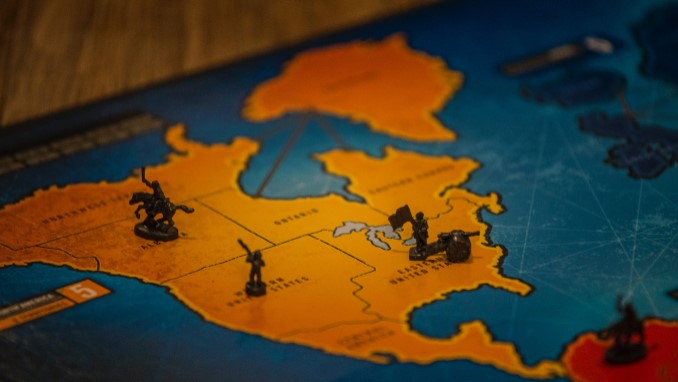
While I’m sure that many people reading this will have their own favourite Strategy game, whether that is ‘light strategy’ like Azul or Catan, or ‘heavier’ ones like Agricola or Brass, what I mean by ‘Good’ in the context of this article is, effective as a games-based learning experience.
Arguably, all games which have a win state (which is the vast majority), require players to adopt some form of strategy, in order to beat either an opponent or the game itself, but not all games will be suitable for learning around Strategy in its real-world sense, which is usually about achieving some outcome through a set of coherent policies, decisions and processes.
What level of strategic thinking is needed?
At the very low end of the strategy (learning) spectrum, games (and puzzles) allow players to create and use ‘strategies’ which are little more than algorithms to be followed. A literal example of this can be found in the solution to the Rubik’s cube, where a prescribed series of steps will always have you arriving at a position of success.

At the other extreme are games where there are potentially as many win states as there are instances of the game being played, or where there is no win state at all. Heavily narrative-based games where the desired outcome is to share a satisfying story-telling experience rather than ‘achieve’ some specific goal, probably fall into this category.
There will so much emergent complexity in terms of what the players will do, and the outcomes of those actions, that it would be extremely difficult for a facilitator (or anyone else) to frame the experience to match a set of desired pre-decided learning outcomes around strategic decision-making or strategic implementation or whatever.
It is not that these behaviours will not have taken place in the game; they very well may have done. It is just that because of the total freedom given to players, they may not ‘teach the lessons’ the outcomes demand.
In between these two extremes is a very wide range of game experiences which can be used to create learning experiences around strategic thinking, and strategic planning and implementation.
What kind of learning do you need?
In an organisational learning setting, ‘Strategy’ learning often comes in one of two flavours. It is either in response to a known strategic challenge (Marketing Strategy, Supply Chain vs Climate Change), where the learning intervention will be more about ideating and innovating strategies to meet that challenge, or it is about capability building, exposing learners to various stimuli to build competence in ‘strategic thinking skills’, for example.
Sometimes, it is not clear which of the above is being attempted, and often learning programmes attempt to do both simultaneously, but it is important to be clear about which of these is the dominant theme of the learning, when selecting a games-based learning route, because it will heavily inform what games are chosen / created.
In the former case, it is often necessary that the game experience should be strongly thematically (and/or mechanically) linked to the desired outcome. If you want players to reach conclusions about the comparative merits of different climate change mitigation measures, they need to get the opportunity to play with different options and to experience the outcomes of these.
Half Earth Socialism is a free-to-play single-player game.
Experiences to support strategic ideation
Simulations are a strong choice for games which look at Strategy in a specific context. However, there are other options, and depending on the context, the theme does not need to be as ‘fitting’ in all cases.
The challenge with simulations is that if you want a simulation which is as close as possible to your situation, it is generally going to mean a custom build, which is an expensive option, unless you are able to reuse the experience very widely.
If you are able to tolerate some level of ‘slack’ e.g. my organisation is in passenger transport, but I am happy to use a simulation about retail toy sales, because ‘customers are customers’, then that opens up your options.

You can even use ‘off the shelf’ game experiences, if you are satisfied that they will allow the testing of sufficiently relevant strategic ‘experiments’. This is what I meant above when I mentioned ‘mechanically’ linked. For example, if your strategic challenge is around ‘resource management’ – as they very often are, there is a rich seam of resource management games, which do not necessarily have to thematically / narratively themed match your challenge.
Terraforming Mars is a game which has considerable promise for strategic ideation and innovation learning (it has a LOT of different strategic decisions you can make, increasing the likelihood it will gel with your specific desired outcome), but also in ‘general’ strategic thinking learning, without requiring your organisation to be in the business of terraforming planets.
Terraforming Mars is available on Amazon
Finally, there are experiences of ‘play’ which do not necessarily count as ‘games’ at all. Lego® Serious Play®, at the higher application levels (for which you will need a certified facilitator, who has been trained in these), is specifically designed to ideate strategies and to ‘stress test’ how they will perform in the presence of systemic influences such as external factors or organisational structures.
Skills-building games
When your learning requirement is more ‘general’, i.e you want your learners to have applicable ‘strategic thinking’ skills, which will be used in different applications throught their careers, it is much less important that you have thematic, or mechanical, congruence with your organisational setting. As mentioned previously, nearly all games require you to apply ‘strategy’ to reach a win-state. What is most important in this ‘general’ learning is that you select / create games with a similar level of complexity (in decisions to be made) and breadth of outcomes, as the setting you are training for (this also applies to the above, in addition to the thematic requirements).
To explain this further, typical learning outcomes for ‘Strategic Thinking’ or ‘Strategic Planning’ programmes include:
- Planning under uncertainty
- Strategy in a VUCA world
- Analysing Risks and Opportunities
- Decision-making with limited information
- Gathering and using data
- Etc.
If you were selecting /creating a game to support these outcomes, it would need to include uncertainty, unforeseeable events that will potentially mess up your planning, both risks and opportunities, and the need to evaluate these to inform decision-making, some way of gathering data, and some urgency in making decisions that will prevent you from waiting until you are fully informed.
It would not really matter if this game was set in Industrial Revolution era Birmingham or 25th century Mars. The presence, or not, of dinosaurs, or magic, or sentient machines, would make no difference (other than potentially adding some fun and excitement).
Brass: Birmingham is available on Amazon
Recommended skill-building experiences
There are game experiences which are specifically designed to meet these kinds of outcomes. One I have been involved in facilitating recently, and can highly recommend is Evivve the Leadership Game, an online experience where a team of players have to work together to evolve to live in a heavily damaged Earth – the alternative is perishing – so about as high stakes as strategic decision-making can get.
The advantage of plumping for a specialist learning game such as Evivve, is that you often (and this is the case with Evivve), get access to qualified facilitators too – or if you are a facilitator, you can get some excellent facilitation training, benefitting from the experience of all those who have gone before.

However, the off-the-shelf route is also available here, and the best advice I can give in selecting a game, is to play, as often as you can, to get a feel for what a game can do in your learning setting.
Of course, the proof of any strategy can only be found in the results of its implementation. What ALL games that qualify as being ‘good’ for learning around strategy require, is that there is scope for learners to exercise autonomy in decision-making and that they will receive useful and timely feedback from the game, which they can feed into further decision-making and evaluation of the strategy they are employing.
Although ‘Luck’ can play a part in such games – the VUCA outcome more or less requires that – a too heavy reliance on luck as a play mechanic, will usually render a game less useful for learning purposes, because there should be some reasonable correlation between ‘skill’ in strategic decision-making and the success of outcomes, so as not to make players too frustrated, and to demonstrate the benefits of good practice.
Keep it fresh with new experiences
It is also interesting to note that repeated play of even complex experiences, will tend to slide those experiences down towards the lower ‘algorithmic’ end of the experience spectrum, as the ‘moves’ to win become better known and practised. To return to the Rubik’s Cube, at some point, someone had to start the process of finding out how to solve the Cube, without a guide on how to do that. If the Strategic Goal was a solved cube, then various strategies can be envisaged – one face at a time, all corners correct and then match faces, etc., eventually, trying all these will have resulted in the best (possibly only, for all I know) strategy being recognised, solve one face, then top two rows, then bottom cross etc.. Different tactics (sequences of moves) are tried to achieve the strategy and eventually a set of operational steps is all that is required to make the thing work – every time.
This is a pretty good analogue of the way Strategic decision-making filters down, via Tactical decision-making to Operational tasks – the algorithms which get the strategy implemented. And by the time that all becomes well-worn BAU, it’s time for a new strategy. Time to pick a new game.
As a certified facilitator in both methodologies, I can create and run strategy learning experiences using Lego® Serious Play® or Evivve, The Leadership Game. I’m also happy to build a programme around an off-the-shelf game, or indeed create a custom game / learning programme for your needs. Get in touch at sarah@ludogogy.co.uk
- James Bore – The Ransomeware Game - 13th February 2024
- Ipsodeckso – Risky Business - 23rd January 2024
- Review – Luma World Games - 15th December 2023





Love this article that reminds a lot of thoughts when we were discussing on our climate change game. Sooner or later I will try to fix all ideas in some mechanics…
Love rerraforming mars.
<3